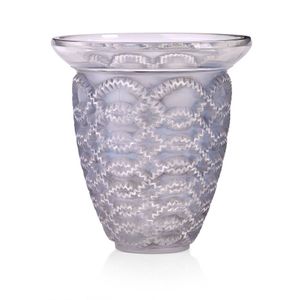Gold Inclusion Murano Glass Vases
You must be a subscriber, and be logged in to view price and dealer details.
Subscribe Now to view actual auction price for this item
When you subscribe, you have the option of setting the currency in which to display prices to $Au, $US, $NZ or Stg.
- Etched - Glass decorated with an etched design, which is achieved through marking out the pattern, protecting the area that is not be etched, and then immersing the object in acid to dissolve the surface of the unprotected area. With some glass objects, such as cameo glass, there may be several layers of different coloured glass, and part of the top layer is dissolved leaving the bottom layer as the background. The longer the time of exposure of the object to acid, the deeper the etching.
The word etching is also sometimes used to describe another method of decoration, where wheel grinders were used decorate the surface, but this technique is usually known as engraving. - Inclusions - Inclusions in glass objects refer to small, often irregularly shaped particles or bubbles that are trapped within the glass during the manufacturing process. These inclusions can be intentional or unintentional, and can range in size, shape, and composition.
Intentional inclusions are often added to the glass for decorative purposes, and can include materials such as colored glass, metallic foils, or even small mementos like photographs or other objects. These intentional inclusions are typically added to the glass while it is still in a molten or semi-molten state and are then moulded or blown into the final shape of the object.
Unintentional inclusions, on the other hand, are typically the result of impurities or air bubbles that become trapped within the glass during the manufacturing process. These inclusions can be seen as small specks or bubbles within the glass, and can sometimes be a sign of poor quality control during production.
While intentional inclusions can be a desirable feature of some glass objects, unintentional inclusions can sometimes be seen as a defect, and can reduce the value of a piece. However, in some cases, certain types of unintentional inclusions can actually increase the value of a piece, such as with antique glass that contains bubbles or other imperfections that are characteristic of the time period in which it was made.
This item has been included into following indexes:
- Barovier & Toso (Italy) - Venetian / Murano glass, makers 112
- Venetian / Murano glass, housewares
Visually similar items

Briar Gardner & Crown Lynn. Wall pocket and vase, both with soft blue glaze application. Wall pocket with full signature. Vase with incised fractional marks (2). Height 26.5 cm. Width 17.5 cm

Two Crown Lynn vases, one earlier with fractional number, incised marks, stiff leaf design, the other with pale blue glaze and impressed mark.84. Heights 14.5 cm and 18.5 cm

A Rene Lalique Guirlandes vase, designed 1935, the tapering cylindrical body moulded with entwined tinsel garlands, in frosted and clear glass with a grey patina, acid etched R. Lalique France, 21 cm high. Provenance: Art Antica, London, Mr Hans Mueller an

A Rene Lalique Lilas vase, designed 1930, the flared cylindrical body moulded to the lower section with intertwined leaves, in frosted and opalescent glass with a remnant blue patina, acid etched R. Lalique, 23.5 cm high. Provenance: Mr Hans Mueller and Mr
